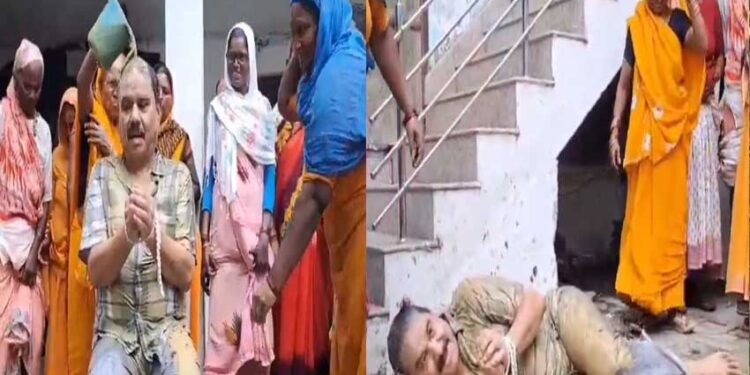Sahitya News Desk!!! Munshi Premchand (English: Munshi Premchand, Born: July 31, 1880 – Death: October 8, 1936) is considered the novel emperor of India whose era extended from 1880 to 1936. This period is of great importance in the history of India. In this era, India’s freedom struggle passed through new stages. Premchand’s real name was Dhanpat Rai Srivastava. He was a successful writer, patriotic citizen, skilled speaker, responsible editor and sensitive creator. In the first half of the twentieth century, when there were no technical facilities to work in Hindi, there was no other writer other than him who could do so much work.[1]
life introduction
Premchand was born on July 31, 1880 in a village named Lamhi, about four miles from Varanasi. Premchand’s father was Munshi Ajaib Lal and mother Anandi Devi. Premchand’s childhood was spent in the village. He was a mischievous and playful child and was adept at stealing vegetables from the fields and fruits from trees. He was very fond of sweets and especially loved jaggery. In his childhood, he received his education in Lamhi and learned to read Urdu and Persian from a Maulvi Sahib. In his childhood, he was beaten badly for stealing a rupee. His story, ‘Kazakhi’, is based on his own childhood memories. Cossack was a courier of the postal department and used to travel long distances. That child always brought some gifts with him for Premchand. In the story he brings a deer fawn for the child and is fired from his job at the post office for arriving late. He returned to the post office very late while running after the deer cub. Kazaki’s personality is immersed in extreme humanity. He is an embodiment of decency and self-respect, but his heart is full of human compassion.
Premchand ji says that the more difficulties people face in surviving in the society, the more crime there will be. If people are happy in the society then there will be more goodness in the society and there will be almost no crime in the society. Premchand made every possible effort to uplift the oppressed class people. He called out, ‘O people, when you have to live in this world, live like the living, what is the use of living like the dead.’
Persona
Premchand, the owner of a simple and straightforward life, was always cheerful. He continued playing with the inequalities and bitterness in their lives. He considered this game as a bet which he always wanted to win. It is said that Premchand was a master of humorous nature. Being humorous in a life full of adversities is a brave act. From this it can also be understood that he was a symbol of extraordinary vitality. He was an embodiment of simplicity, courtesy and generosity. While he had a generous feeling for his friends, he also had an immense ocean of sympathy for the poor and the suffering. Premchand was a high class human being. He loved village life. He always lived in simple rustic clothes. He spent most of his life in the village. Premchand, who looked absolutely ordinary from outside, was a master of vitality from within. If anyone looked even a little inside, he was bound to be impressed. He lived miles away from ostentation and ostentation. He neither got luxury in life nor did he desire it. Like all great men, he liked to do his own work.
literary life
Premchand was his literary name and he adopted this name many years later. His real name was ‘Dhanpat Rai’. When he started writing stories while serving in government, he adopted the name Nawab Rai. Many friends continued to address him as Nawab throughout his life. He had written a small book on Sheikh Saadi in Hindi, had translated some of Tolstoy’s stories into Hindi and was also adapting some of the stories of ‘Prem-Pachisi’ into Hindi. These stories first appeared before the Hindi world in 1917 under the title ‘Sapta-Saroj’. These seven stories were:-
Perhaps few people know that the famous storyteller Munshi Premchand first outlined his great works. English I used to write and after that Hindi Or Urdu Used to be translated and expanded.
Daughter of a big house, Step-in-law, Punishment of gentlemanliness, God, Inspector of salt, Sermon, Test
These stories are counted among the best stories of Premchand.
Characteristics of literature
Premchand’s creative vision was expressed in various literary forms. He was a versatile talented writer. Contemporary history speaks through the works of Premchand. In his works, he gave a poignant portrayal of the feelings, circumstances and problems of the common people. His works are the most extensive and comprehensive works of India. Through his stories, Premchand emphasizes the basic importance of human nature. ‘Anandi, the daughter of a big house,’ is unhappy with her brother-in-law, because that barbarian speaks harshly to her and throws a stool at her. When she realizes that their family is falling apart and her brother-in-law is full of grief, she forgives him and calms her husband down.
Premchand’s letters
Premchand may have written thousands of letters in his lifetime, but among his letters which have survived the era and are available today, the most letters are those which he wrote to the famous editor of the popular Urdu monthly magazine ‘Zamaana’ of his time. Munshi had written to Dayanarayan Nigam. Although Munshi Dayanarayan Nigam was two years younger than Premchand, Premchand always respected him like an elder brother. It is a very difficult task to define the mutual relationship between these two personalities, but the reason for this feeling of respect for Premchand seems to be that Nigam Saheb has done the great work of giving recognition to Premchand in the literary world by continuously publishing him in ‘Zamaana’. It was edited, and it was even published in the magazines of that time that if anyone has the credit for making Premchand Premchand, then it is Munshi Dayanarayan Nigam.
This was the golden age of Premchand’s novel art. Gaban was published in early 1931. On April 16, 1931, Premchand started another of his great works, Karmabhoomi. It was published in August, 1932. According to Premchand’s letters, he had started writing his last great novel, Godaan, in 1932 itself, although due to many difficulties related to ‘Hans’ and ‘Jagran’, its publication was possible only in June 1936. During his last illness, he started writing another novel, ‘Mangalsutra’, but it remained incomplete due to his untimely death. Any writer in the world can be proud of the novel trilogy ‘Ghaban’, ‘Karmabhoomi’ and ‘Godaan’. ‘Karmabhumi’ is especially important because of its revolutionary consciousness.
Premchand was his literary name and he adopted this name many years later. His real name was ‘Dhanpat Rai’. When he started writing stories while serving in government, he adopted the name Nawab Rai. Many friends continued to address him as ‘Nawab’ throughout his life.
Premchand and cinema
Premchand is one of the most popular writers of Hindi cinema. Two years after his death. Subramaniam made a film based on the novel Sevasadan in 1938 in which Subbulakshmi played the lead role. Other films have also been made on some of Premchand’s stories, such as Satyajit Ray’s film Shatranj Ke Khiladi.[4] Premchand wrote dialogues for the film titled Mazdoor. The film’s owners had prepared the story outline. The film had the story of a patriot-loving mill owner, but the censor could not tolerate even this. Nevertheless the film was screened in Punjab, Delhi, Uttar Pradesh and Madhya Pradesh. The film had such an impact on the workers that the police had to be called. Ultimately the Indian government banned the release of the film. In this film, Premchand himself appeared on the silver screen for a few moments. He came into the role of arbiter in a conflict between workers and owners. In an article, Premchand has expressed his anger and dissatisfaction over the condition of cinema. He compares the aims of literature:
The highness of literary sentiments, the maturity and clarity of language, the cultivation of beauty, we Cinema I don’t get it.
award
In memory of Munshi Premchand, the Indian Postal Department issued a postage stamp worth 30 paise on the occasion of his birth centenary on July 31, 1980. Premchand Sahitya Sansthan has been established in the school of Gorakhpur where he was a teacher. There is a fresco in its verandah, the picture of which is given on the right. There is also a museum of things related to him Where there is also a bust of him. Premchand’s wife Shivrani Devi wrote his biography under the name Premchand Ghar and has exposed that part of his personality of which people were unaware. His own son Amrit Rai has written his father’s biography under the name ‘Kalam Ka Sipahi’. Not only have English and Urdu versions of all his books been published, his stories have become popular in many foreign languages like Chinese, Russian etc.
Criticism
Due to the increasing fame of Premchand, some people were feeling very angry and jealous. One of them, Shri Awadh Upadhyay, filed a case of plagiarism against Premchand and six month Wrote articles till. With the help of accepted formulas of algebra, he continued to prove that-
A+B+C/D = P+F+B/D
That is, 1/3 of Premchand’s Sophia reminds 1/4 of Thackeray’s Amelia. Another unsuccessful storyteller, assuming the guise of a critic, had called Premchand a ‘propagator of hatred’.
death
Except for one year of his last days (1934-35, which was spent in the film world of Mumbai), his entire time was spent in Varanasi and Lucknow, where he edited many newspapers and magazines and continued creating his literature. He died of ascites on October 8, 1936.[4] In this way, that lamp was extinguished forever which lit the path of Indians by burning its wick of life bit by bit.










